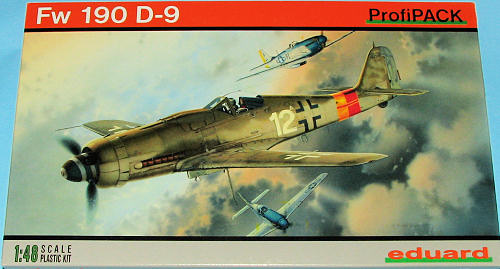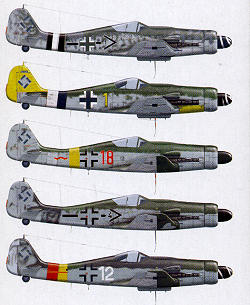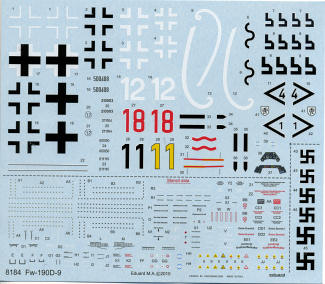
| KIT #: | 8184 |
| PRICE: | $40.00 MSRP ($33.95 at www.greatmodels.com ) |
| DECALS: | Five options |
| REVIEWER: | Scott Van Aken |
| NOTES: | Profipack |

| HISTORY |
The Fw 190 D (nicknamed the Dora; or Long-Nose Dora, "Langnasen-Dora") was intended to improve on the high-altitude performance of the A-series enough to make it useful against the American heavy bombers of the era. In reality, the D series was rarely used against the heavy bomber raids, as the circumstances of the war in late 1944 meant that fighter-versus-fighter combat and ground attack missions took priority. A total of 1,805 D-9s were produced. Production started in August 1944 with the variant entering Luftwaffe service in September 1944 with III./JG 54.
The liquid-cooled 1,750 PS (1,726 hp, 1,287 kW) Jumo 213A could produce 2,100 PS (2,071 hp, 1,545 kW) of emergency power with MW 50 injection, improving performance to 426 mph (686 km/h) at 21,650 ft (6,600 m). Early D-9s reached service without the MW 50 installation, but in the meantime Junkers produced a kit to increase manifold pressure (Ladedrucksteigerungs-Rüstsatz) that increased engine output by 150 PS to 1,900 PS, and was effective up to 5,000 m (16,400 ft) altitude. It was fitted immediately to D-9s delivered to the units from September, or retrofitted in the field by TAM. By the end of December, all operational Doras, 183 in total, were converted. From November 1944, a simplified methanol-water (MW 50) system (Oldenburg) was fitted, which boosted output to 2,100 PS. By the end of 1944, 60 were delivered with the simplified MW 50 system or were at the point of entering service. The 115 L tank of the Oldenburg system would hold the MW 50 booster liquid, which was single-purpose, while later systems were to be dual-purpose, holding either MW 50 or additional fuel.
Due to the failure of multiple attempts to create an effective next-generation 190, as well as the comments of some Luftwaffe pilots, expectations of the Dora project were low. These impressions were not helped by the fact that Tank made it very clear that he intended the D-9 to be a stopgap until the Ta 152 arrived. These negative opinions existed for some time until positive pilot feedback began arriving at Focke-Wulf and the Luftwaffe command structure. Sporting excellent handling and performance characteristics, it became very clear that the D-9 was nearly the perfect response to the Luftwaffe's need for an effective medium altitude, high-speed interceptor, although its performance still fell away at altitudes above about 20,000 ft (6,100 m). When flown by capable pilots, the Fw 190D proved to be a match for P-51s and Mk. XIV Spitfires.
While the first few Doras were fitted with the flat-top canopy, these were later replaced with the newer rounded top "blown" canopy first used on the A-8 model. With the canopy changes, the shoulder and head armour plating design was also changed. Some late model Doras were also fitted with the Ta 152 vertical stabilizer and rudder, often called "Big Tails" by the Luftwaffe ground crews and pilots as seen on W.Nr. 500647 Brown 4 from 7./JG 26 and W.Nr. 500645 Black 6 from JG 2).
As it was used in the anti-fighter role, armament in the "D" was generally lighter compared to that of the earlier aircraft—usually the outer wing cannon were dropped so that the armament consisted of two 13 mm (.51 in) MG 131 machine guns and two 20 mm MG 151/20 E wing root cannon, with all four weapons synchronized to fire through the propeller arc. While inferior to the A-series in roll rate, the "D" was superior in turn rate, climb, dive and horizontal speed. The Dora still featured the same wing as the A-8, however, and was capable of carrying outer wing cannons as well, as demonstrated by the D-11 variant, with a three-stage supercharger and four wing cannon (two MG 151s and two MK 108s).
The first Fw 190 D-9s started entering service in September 1944 with III./JG 54. It was quickly followed by many, including I./JG 26, starting 16 November to convert to the new fighter from the A-8.
| THE KIT |
 Much
bally-ho has been made of this kit by those who want the latest and greatest,
and apparently it was been pretty much deserved. The kit itself is very nicely
molded with all the surface detailing that one could ask for. One thing that
surprised me as I was handling the sprues, was how thin and flexible the
airframe parts were. In fact, one could easily bend the fuselage in the cockpit
area, so I have to think that one needs to be quite careful of the pieces to
keep from accidentally breaking them.
Much
bally-ho has been made of this kit by those who want the latest and greatest,
and apparently it was been pretty much deserved. The kit itself is very nicely
molded with all the surface detailing that one could ask for. One thing that
surprised me as I was handling the sprues, was how thin and flexible the
airframe parts were. In fact, one could easily bend the fuselage in the cockpit
area, so I have to think that one needs to be quite careful of the pieces to
keep from accidentally breaking them.
Apparently Eduard has listened to the complaints about not being able to build the kit with various panels closed as this one provides optional pieces to allow the builder to do just that. I have to applaud Eduard for making this change as there are those of us who don't like our models with all the panels opened. In addition to the usual sprues, this is a Profipack version so that mean a photo-etch sprue. In fact, the kit cannot be totally completed without the p.e. as this material is used for all the interior levers and the radio mast, to name a few items. This kit also breaks new ground by including an engine accessory unit that one can see when looking into the wheel wells. Previous 190D kit simply put in the usual blocking plate as came with the 190A.
 While on the
subject of the p.e. fret, this material is pre-painted and used for instrument
and console panels as well as the harness and other smaller items. To use these
for consoles the instruments will need to be ground away. A flat instrument
panel is supplied along with a standard one. The kit also includes two types of
tires, smooth and radial tread as well as two different canopies, the 'flat' top
and 'blown' version. Interestingly, you are provided with two of each canopy,
each with a different part number and for the life of me, I can see no
difference. Parts not used on the clear sprue include some armor sections that
will prove to be very useful for a Rammjaeger 190A-8.
While on the
subject of the p.e. fret, this material is pre-painted and used for instrument
and console panels as well as the harness and other smaller items. To use these
for consoles the instruments will need to be ground away. A flat instrument
panel is supplied along with a standard one. The kit also includes two types of
tires, smooth and radial tread as well as two different canopies, the 'flat' top
and 'blown' version. Interestingly, you are provided with two of each canopy,
each with a different part number and for the life of me, I can see no
difference. Parts not used on the clear sprue include some armor sections that
will prove to be very useful for a Rammjaeger 190A-8.
For things under wings, you have either a drop tank or a bomb. Ailerons and rudder are separate, though there is no indication that they are to be affixed in anything other than the neutral position. No separate flaps are provided but I'm not sure these were normally deployed when on the ground anyway.
 The
instruction booklet is quite well done with lots of notes and what has to be
added/removed for which of the markings options the modeler is doing. Colors are
strictly Gunze with RLM numbers provided where applicable. There are five
markings options. Black Winkel 1 is from Stab./JG4 and is in RLM 75/83/76 with
unpainted metal sect
The
instruction booklet is quite well done with lots of notes and what has to be
added/removed for which of the markings options the modeler is doing. Colors are
strictly Gunze with RLM numbers provided where applicable. There are five
markings options. Black Winkel 1 is from Stab./JG4 and is in RLM 75/83/76 with
unpainted metal sect ions
of the lower wing. Yellow 1 with the yellow tail is Hans Dortenmann's plane from
I./JG 26 in early 1945. A similar plane of Dortenmann's, Black 1, is also on the
sheet. Both are in RLM 75/83/76. Red 18 is from one of two units at Pisen,
Czechoslovakia at the end of the war. It is in RLM 82/83/76 with the aft section
of the lower wing unpainted. Black Winkel 4 was from Stab./JG 6 at Prague,
Czechoslovakia at the end of the war. It is painted in a very similar manner as
the previous plane and also has the rear of the lower wing unpainted. The final
option is White 12 of 5./JG301 in Germany, also at the end of the war. It is in
a mixture of colors as the wings are RLM 75/83 while the fuselage is RLM 81/82
and the forward section of the wings was in RLM 83, like most of the others with
unpainted aft wing sections. The large decal sheet is well printed and provides
a full stencil suite.
ions
of the lower wing. Yellow 1 with the yellow tail is Hans Dortenmann's plane from
I./JG 26 in early 1945. A similar plane of Dortenmann's, Black 1, is also on the
sheet. Both are in RLM 75/83/76. Red 18 is from one of two units at Pisen,
Czechoslovakia at the end of the war. It is in RLM 82/83/76 with the aft section
of the lower wing unpainted. Black Winkel 4 was from Stab./JG 6 at Prague,
Czechoslovakia at the end of the war. It is painted in a very similar manner as
the previous plane and also has the rear of the lower wing unpainted. The final
option is White 12 of 5./JG301 in Germany, also at the end of the war. It is in
a mixture of colors as the wings are RLM 75/83 while the fuselage is RLM 81/82
and the forward section of the wings was in RLM 83, like most of the others with
unpainted aft wing sections. The large decal sheet is well printed and provides
a full stencil suite.
| CONCLUSIONS |
Those of you who have to have the latest will have already grabbed this one. The rest of us who are on the fence about it will be pleased with what they get once the price comes down and we can get it at a discount. If you are a 190D fan, you should seriously consider this one.
| REFERENCES |
http://en.wikipedia.org/wiki/Focke-Wulf_Fw_190
April 2010
You can find this and many other nice kits and accessories at www.greatmodels.com
If you would like your product reviewed fairly and quickly, please contact me or see other details in the Note to Contributors.